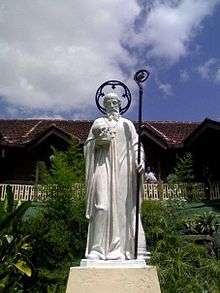Sylvester Gozzolini
| Saint Sylvester Gozzolini | |
|---|---|
|
15th-century Italian painting depicting Saint Sylvester Gozzolini. Artist unknown. | |
| Born |
1177 Osimo |
| Died |
November 26, 1267 Fabriano |
| Venerated in | Roman Catholic Church |
| Beatified | 1260s by Clement IV |
| Canonized | 1598 by Clement VIII |
| Major shrine | Church of Monte Fano |
| Feast | 26 November |
Sylvester Gozzolini (Italian: Silvestro Guzzolini; 1177 – November 26, 1267) was an Italian saint, the founder of the religious order known as the Sylvestrines, a branch of the Benedictines.
Life
Born of the noble family of the Gozzolini at Osimo, Marche, he was sent to study jurisprudence at Bologna and Padua, but feeling a call to the ecclesiastical state, abandoned the study of law for that of theology and Holy Scripture. On his return home we are told that his father, angered at his change of purpose, refused to speak to him for ten years. Sylvester then accepted a canonry at Osimo and devoted himself to pastoral work with such zeal as to arouse the hostility of his bishop, whom he had respectfully rebuked for the scandals caused by the prelate's irregular life.[1]
Gozzolini was threatened with the loss of his canonry, but decided to leave the world on seeing the decaying corpse of one who had formerly been noted for great beauty. In 1227, he retired to a desert place about thirty miles from Osimo and lived there in the utmost poverty until he was recognized by the owner of the land, a certain nobleman named Conrad, who offered him a better site for his hermitage. From this spot he was driven by dampness and next established himself at Grotta Fucile, where he eventually built a monastery of his order.[1]
In this place his penances were most severe, for he lived on raw herbs and water, and slept on the bare ground. Disciples flocked to him seeking his direction, and it became necessary to choose a rule. According to the legend, the various founders appeared to him in a vision, each begging him to adopt his rule. Gozzolini chose for his followers that of St. Benedict and built his first monastery on Montefano, near Fabriano, after first destroying the remains of a pagan temple.[1]
In 1248, he obtained from Innocent IV, at Lyon, a papal bull confirming his order, and before his death founded eleven monasteries in Italy. Sylvester died at the age of ninety on November 26, 1267.[2]

An account of his miracles and of the growth of his cultus can be found in Bolzonetti. His body was disinterred and placed in a shrine (1275–85) and is still honoured in the church of Monte Fano. Clement IV first recognized the title of blessed popularly bestowed on Sylvester, who was inscribed as a saint in the Roman Martyrology by order of Clement VIII in 1598. His office and Mass were included in the General Roman Calendar in 1890 by Leo XIII with the rank of Double (third-class feast in the 1960 reform of Pope John XXIII), for celebration on 26 November, reducing to the status of a commemoration the celebration of Saint Peter of Alexandria, whose feast-day 26 November had been previously. In 1970, the celebration of Saint Sylvester Gozzolini was removed from the General Roman Calendar and left to local calendar as not of really universal importance.[3]
See also
References
- 1 2 3 Webster, Douglas Raymund. "St. Sylvester Gozzolini." The Catholic Encyclopedia. Vol. 14. New York: Robert Appleton Company, 1912. 30 Jan. 2014
- ↑ Butler, Alban. Lives of the Saints, Vol. XI, (1866)
- ↑ Calendarium Romanum (Libreria Editrice Vaticana 1969), p. 147
| Wikisource has original text related to this article: |
![]() This article incorporates text from a publication now in the public domain: Herbermann, Charles, ed. (1913). "article name needed". Catholic Encyclopedia. New York: Robert Appleton.
This article incorporates text from a publication now in the public domain: Herbermann, Charles, ed. (1913). "article name needed". Catholic Encyclopedia. New York: Robert Appleton.
